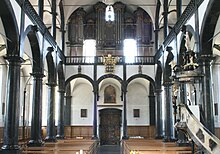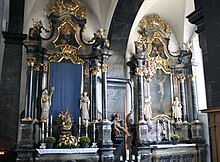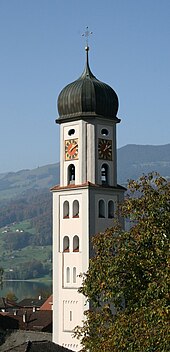Sachseln parish and pilgrimage church

The parish and pilgrimage church of Sachseln with the patronage of St. Theodul is a Roman Catholic church in Sachseln in the canton of Obwalden . In addition to its function as the parish church of Sachseln, the church also serves as a pilgrimage church for the Swiss national saint Niklaus von Flüe , who is also known as Brother Klaus . It was consecrated in 1684 and is a listed building as a cultural asset of national importance .
history
The old parish church
The previous church was a small, Romanesque hall church that was oriented across the current church to the east. It existed at least since 1234, as it was first mentioned in a document that year. Like today's church, it was consecrated to St. Theodul , bishop of Valais , and St. Mauritius , the leader of the Theban Legion, was chosen as the second church patron . At the beginning of the 15th century the church was closed for decades and Sachseln had no pastor from 1415 to 1446. After an extension by the choir, the church was consecrated on August 30, 1459. Brother Klaus was buried in this church after his death on March 21, 1487. This was absolutely unusual for a layman in rural areas. In contrast to the priests, who were buried facing the people, i.e. with their heads facing west towards the community, Brother Klaus was buried with his head facing east, i.e. facing the Holy Land . Only five years after the death of Brother Klaus, a life-size picture was painted of him as the altar wing of the Gothic altar of the old parish church. This early honor was also quite unusual, but the picture was painted on the back of the wing so that it could be folded down during official visitations and only the painting on the front was visible. It is believed that his second eldest son, who most resembled the father, was a model. Because of this, and because of its early creation, the portrait has a high level of credibility in the depiction of the hermit. When the old church was demolished in 1679, the altar disappeared without a trace. Only in 1945 did the altar wing reappear as the back wall of a wardrobe in the Bunzlisflue house in Sachseln. Today it is considered the most important piece in the collection of the Brother Klaus Museum in Sachseln.
Planning for the new church
In 1649 Innocent X gave permission for the liturgical veneration of Brother Klaus, which corresponds to an "equivalent" beatification (beatificatio aequipollens). His successor Clement IX. confirmed on March 8, 1669 again the permission for the liturgical veneration of Brother Klaus as Blessed, restricted to the parish church of Sachseln. This created a growing stream of pilgrims to Sachseln, for which the old church was too small. As a result, the construction of a larger church was planned from 1671. Since the patronage rights over the Sachsler church had been with the Obwalden government since it was taken over by the Habsburgs in 1415, their approval for the new church was required, which took place on May 9, 1671. The regional authorities also promised advice and help and so special taxes were decreed. In 1672 the Landsgemeinde passed a state tax of one pound of butter per “melchen Kuh” (milk cow), the Sachsler had to pay two pounds. In 1679 there was a second state tax of 10 shillings on 1,000 pounds of property (1 pound = 20 shillings), and in Sachseln twice that was payable again. The people also had to do labor; The black “marble” (actually black limestone) broken for the eight pillars in Melchtal near Stöckalp was brought to the construction site by assistants from all Obwalden communities. The difficult transport of the eight mighty, monolithic columns from the Melchtal via Kerns to Sachseln still lives on in folk tales today.
Construction phase 1672–1684
The papal nuncio Odoardo Cybo laid the foundation stone on June 12, 1672 and the construction of the new church began. While the old church faced east, today's church was built at a right angle to it, west of the tower. Thus, services could continue to be celebrated in the old church during the new building.
The builder was Hans Winden from Ruswil, who was probably also the author of the plan. According to a traditional statement, Hans Winden and others crashed while building a church on April 13, 1677 and died. An inscription carved in stone was affixed to the church wall: "The artful master of the first building, Hans Winden von Ruswil, died here on April 13th, 1677".
In July 1679 the nave was completed, so that on August 28, 1679 the oak coffin with the bones of Brother Klaus could be transferred to the new church. On September 4th of the same year the demolition of the old Romanesque church began and the new choir was built in its place . At Pentecost 1683 the first office could be celebrated there. The Marienkapelle, which Pastor Jakob Sigerist, later abbot of Engelberg Monastery , built around the Brother Klaus tomb in 1600, has survived. Around 1703 an ossuary was built on this chapel and in 1878 both buildings were merged to form today's burial chapel .
The church construction took 12 years from 1672 to 1684; on October 7, 1684, the church was consecrated by Auxiliary Bishop Georg Sigismund Müller of Constance .
Design, additions and renovations
The church roof had to be renewed in 1822, in 1827 and 1833 the church was repainted. The organ gallery was given a new wooden floor in 1832 and in 1834 the order was placed with the organ builder Franz Anton Kienne (1777–1847) from Langenargen on Lake Constance to build a new organ. This cost 3,310 guilders and 27 shillings and was completed in 1839. To finance the new organ, the sale of 50 to 100 oaks from the Melchtal was planned, which were loosened through the Melchaa. The community donation advanced the cost of organ building without interest; the debt could only be paid off slowly. In 1846 Josef Marzell Müller (* 1789) von Gersau framed the organ with stucco work.
In 1729 Johann Heinrich Lussi from Stans had painted pictures from the legend about Brother Klaus on both sides of the church portal. These were later replaced by two votive tablets , which represented the daily statute in Stans and the three hermits Brother Klaus , Brother Ulrich and Brother Konrad Scheuber . These were refreshed in 1825 by Josef Anton Heymann (1758–1837) and later again by Nikolaus Huwiler (1822–1902). In 1904 paintings by Anton Stockmann (1868–1940) replaced the older depictions. Finally, in 1941, two mosaic pictures were made by the Vatican mosaic workshops based on the motifs of Anton Stockmann.
Paul Deschwanden from Stans was commissioned to rework the high altar in 1881. Together with his student and colleague Georg Kaiser, he replaced the old painting with a representation of the Assumption of Mary into heaven. With a view to the anniversary of the Brother Clause the following year, the church floor was paved with stone slabs and the pews renovated in 1886.
Between 1974 and 1976 the church was extensively renovated for 4.75 million francs. The main task was to preserve the structure and to restore the light solemnity of the interior. In adaptation to the liturgical reform of the Second Vatican Council , a free-standing celebration altar was set up.
From November 2012 to June 2013 the church was renovated for around 1 million Swiss francs, with the sooty ceilings and walls being cleaned and lime painted by the sacrificial candles . In the following winter, the organ was revised and technical improvements were made to the fire protection.
Architectural style
The hall church consists of a barrel-vaulted central nave, which is accompanied by two side aisles with large galleries . The design with galleries was chosen because of the expected large flow of pilgrims. This architecture is reminiscent of an Italian inner courtyard with two arched loggias over columns. The style of the building belongs to the Swiss early baroque with elements of the Italian Renaissance . At the time of its creation, there was little comparable to the Sachsler Church in central Switzerland in terms of size and charisma. The interior of the church is characterized by the contrast “black and white”. The eight columns made of black limestone from the Melchtal carry round arches made of the same material. The balustrades of the galleries and the columns that continue there, again with round arches above, are in black. In contrast, the walls and ceilings are white.
Furnishing
Choir and altars
The altars and the pulpit were made from stucco marble by Josef Pfister from Lucerne from 1776 to 1779. They are kept in a lively and elegant Rococo style and thus form a contrast to the otherwise serious dominance of the architecture. The main picture of the high altar shows the Assumption of Mary into heaven . It was painted by Paul von Deschwanden and Georg Kaiser in 1881. The top sheet with the Trinity above was created by Anton Heymann. On the right and left side of the high altar are statues of the church patron Theodul and Mauritius . Above are the saints of the plague and epidemics, important for the time, Sebastian and Rochus . The altar is crowned by the old coat of arms of Obwalden : divided into red and white, still without a key.
- The statues of saints on the side altars
The left side altar shows on the left the altar painting "Maria as Patroness of the Rosary Brotherhood " by Josef Anton Heymann, framed by the statues of saints Barbara (left) and Katharina (right). In the right-hand part is " Mariä Sacrifice " from 1775 by Johann Melchior Wyrsch , framed by Saint Joseph and John the Baptist .
The right side altar shows on the left the Descent from the Cross , also by Johann Melchior Wyrsch from 1776, framed by Saints Benedict and Dominik . On the right side finally «Jesus on the Cross» by Josef Anton Heymann, framed by Saint Peter and John the Evangelist .
Brother Klaus' grave is located in the free-standing main altar, which was created in 1976 by Alois Spichtig . In the block altar there is a cavity closed at the front with a glass pane. It shows the life-size, silver-gilt figure of the saint, which was created in 1934 by the goldsmith Meinrad Burch-Korrodi . In the figure, the relics of Brother Klaus are kept in a chrome steel container.
There are two large paintings on the two side walls of the choir. On the left is Karl Borromeo , painted by Paul von Deschwanden in 1860. On the right is a picture of Brother Klaus by an unknown 17th century painter.
sign
The two mosaics under the sign were made by the Vatican mosaic workshops in 1941. They replaced older paintings with the same motifs by Anton Stockmann. On the left side the legendary Marian apparition of Brother Klaus in the Ranft , on the right the traditional and equally legendary depiction of “Brother Klaus at the Tagsatzung zu Stans”. Brother Klaus is shown in the middle of the daily statute, whereby the historical tradition reports that Brother Klaus was not there, but the pastor of Stans, Heimo Amgrund, went to Brother Klaus in the Ranft and from there with a council of the hermit back to the Diet rushed. In the middle is the single-winged portal made of wood, richly decorated with winding columns on the right and left and a Brother Klaus figure on the central pilaster . On the right side a plaque commemorates Heinrich Federer , poet and honorary citizen of Sachseln.
Further equipment
The baptismal font is in the back of the church . The pillar canopy above was placed in the choir from 1732 to 1934, where it blocked the view of the high altar. Below him was the openly presented relic of Brother Klaus, set in pearls, in a kneeling representation.
In addition to the relics, two other mementos of Brother Klaus are on display in the church. In the right transept, in an air-conditioned showcase, there is Brother Klaus' «Hermit Skirt», spun, woven and sewn by his wife Dorothea according to old tradition. The skirt has been venerated in the church since 1610 and was restored in 1975 in the textile atelier of the Swiss National Museum . Another original rock is exhibited in the Jesuit Church in Lucerne . Next to the showcase is the bronze relief “Dorothee and Brother Klaus”, which was created by Alois Spichtig in 1984 for the visit of Pope John Paul II . In front of the left side altar is a copy of Brother Klaus' contemplation picture (meditation picture) . It represents an embodiment of the simple wheel picture. The original canvas panel was painted around 1475/80 and given to Brother Klaus.
Gallery and organ
In the middle of the balustrade of the rear gallery is a coat of arms carved in wood, which is reminiscent of the first high altar from 1687, which the Swiss Benedictine monasteries had donated.
The organ comes from the organ builder Franz Anton Kiene (1777–1847) and his son Johann Nepomuk Kiene from Langenargen on Lake Constance and was completed in 1839. It was restored in 1976 by Mathis Orgelbau AG. The stucco work to surround the organ prospect dates from 1846 and was carried out by Josef Marzell Müller (* 1789) from Gersau .
The instrument has 29 registers , divided into two manuals and pedal :
|
|
|
||||||||||||||||||||||||||||||||||||||||||||||||||||||||||||||||||||||||||||||||||||||||||||||||||
- Coupling : OW - HW, OW - PED, HW - PED.
- Auxiliary step: Organo pleno on / off.
- Mechanical play and stop action.
Church treasure
The church treasure is kept in the sacristy. It consists, among other things, of a Romanesque, bronze lecture cross from the 12th century, a Gothic monstrance from 1516 with the figure of Brother Klaus in a sprinkling, and a silver drinking bowl in which St. Charles Borromeo was given the honorary drink on his pilgrimage to Sachseln in 1570 . The canonization bull and the Sachsler church book from 1488 are also part of the church treasury.
Steeple
The origin of the free-standing, late Romanesque tower dates back to the 13th century. The lower part has been preserved from the smaller previous church. It was raised by two floors when the new church was built in 1672. After a fire caused by a lightning strike, the tower was raised a second time in 1742 and given a baroque onion dome. The burial chapel is built onto the tower . Inside is the former resting place of Brother Klaus with the grave slab of Konrad Lux . At the foot of the tower is the bronze sculpture "Dorothea", which shows Brother Klaus's wife with three of their children when they say goodbye to Brother Klaus. The sculpture was created in 1991 by Rolf Brem on behalf of the Catholic peasant women in Switzerland.
Bells
There are five bells in the tower. The largest has a weight of 2930 kg. The tuning of the bells is H '- G' - DIS '- CIS' - H0.
Surroundings
To the south of the church is the Sachsler village square, where the Kronenhaus stands as a neighboring building, a half-timbered building from 1680. To the east of the church is the former parsonage, in which the pilgrimage secretariat Brother Klaus is housed. The cemetery is attached to the church and the former rectory. Behind it is the parish hall. Diagonally across from the parish hall is the parish office at Pilatusstrasse 3.
literature
- Werner Stöckli, Jachen Sarott: The building history of the parish and pilgrimage church St. Theodul zu Sachseln. In: Journal for Swiss Archeology and Art History . Vol. 36, issue 1/1979, pp. 28-43, doi: 10.5169 / seals-167214 .
- Niklaus von Flüe : Sachseln in the 19th century. Chronicle and history of the community . Self-published, Kerns 2006. P. 137 ff. (Chapter 9: Parish church and chapels ).
Web links
- The parish and pilgrimage church of Sachseln - information page on the website of the pilgrimage secretariat in Sachseln
- Guide through the Sachseln Church (PDF; 372 kB) - information sheet from the pilgrimage secretariat in Sachseln
Individual evidence
- ↑ a b c Place of grace for the pilgrims to the grave of Brother Klaus, 325 years of the Sachseln parish church (PDF; 914 kB) Article in the Obwalden parish gazette, 18/2009, September 27th to October 17th, pp. 2-3.
- ↑ Historical altar wing on the move , article in ONZ Obwalden and Nidwalden Zeitung from September 14, 2011 ( Memento from January 15, 2013 in the web archive archive.today )
- ↑ see companion by the church Sachseln at the web links
- ↑ Sacrificial candles soot the church , article from Central Switzerland on Sunday May 27, 2012
- ↑ The church went through a makeover , article in the Neue Obwaldner Zeitung of June 2, 2013, p. 17
- ↑ Information board in the church next to the showcase
- ^ Sachseln (CH), pilgrimage and parish church information page of Mathis Orgelbau AG
- ^ The parish and pilgrimage church of Sachseln , see web links.
- ^ The Bells of St. Theodul Church at Sachseln (Obwalden), Switzerland. (Whole Peal) Video on youtube.com
Coordinates: 46 ° 52 '3.5 " N , 8 ° 14' 23.6" E ; CH1903: 661090 / 191033






















